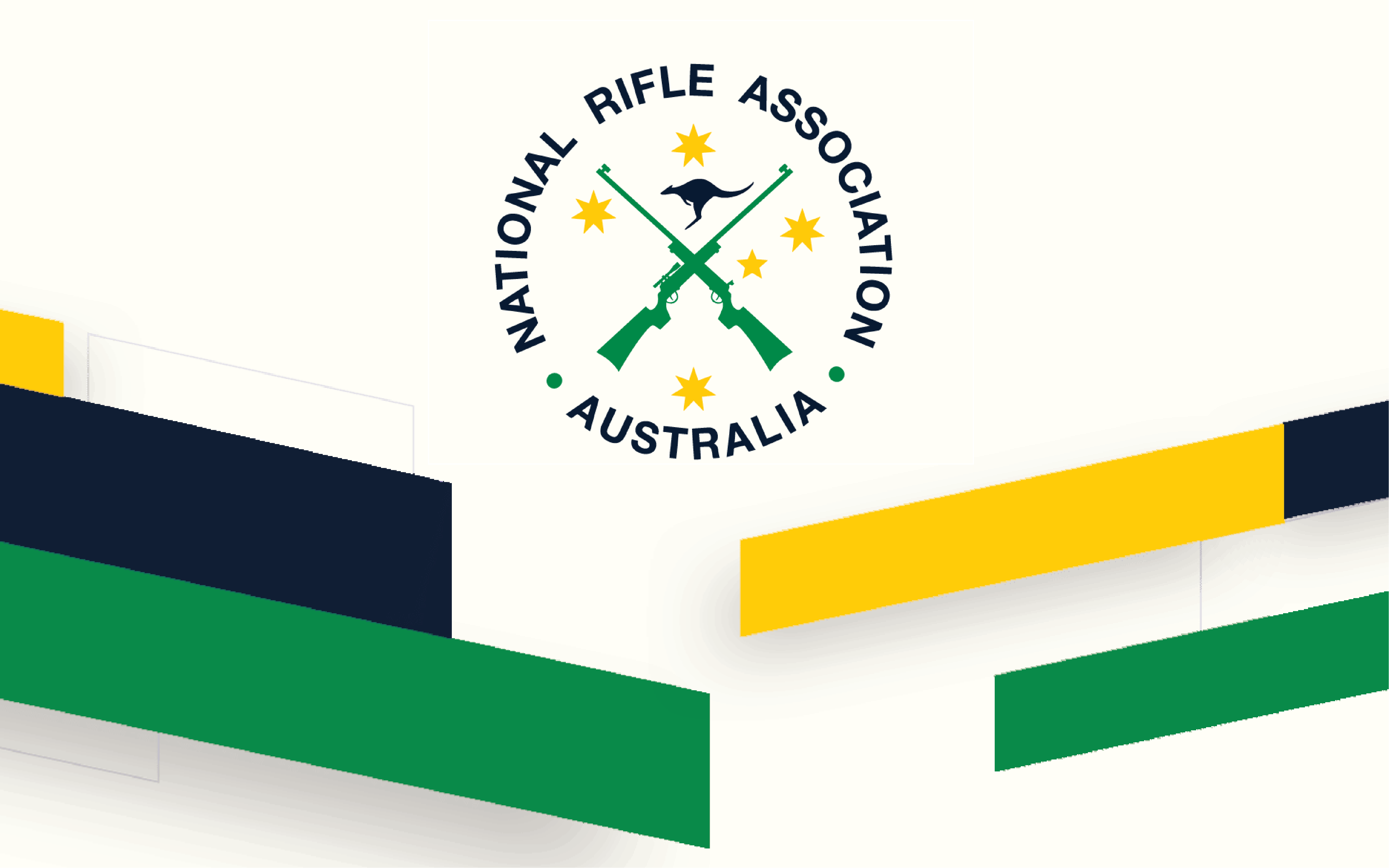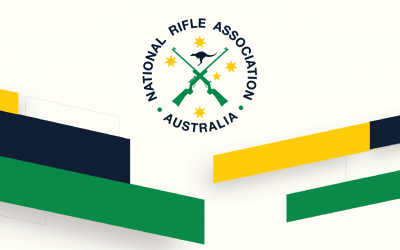Around 1915 when some Rifle Clubs were formed to encourage enlistment we find a number of obsolete rifles being used for drills most probably beginning with Martini Henry Rifles. The Martini Enfield Carbine (ME) was also available in limited numbers .
The ME was a rifle from the late 1800’s, many of which were converted to the .303″ cartridge. These were being used by Mosman-Neutral Bay Rifle Club’s in 1916 for their Musketry practice as noted in Club Minutes of the time.

The Martini Enfield, (ME) Rifle[1]
Long Toms
Later, MLE (Magazine Lee Enfield) rifles became available. The MLE, one of the “Long Lees” and sometimes known as the “Long Tom” was actually released in 1895. The “Long” part of the MLE’s nickname referred to the overall length of the rifle being an extended 49.5″. The more famous SMLE (Short Magazine Lee Enfield) was 44.5″ and already in production from around 1902/03. This was the Mark 1 SMLE.

The Magazine Lee Enfield (MLE) Rifle[2]
Cutdowns
Another rifle pattern was released in 1904 called the “Australian Rifle Club Pattern”, a Lee Enfield Carbine[i]. This particular rifle pattern was simply a modification by shortening the barrel length of the Magazine Lee Enfield and possibly some of the still existing Magazine Lee Metfords. This pattern was introduced at the same time as the SMLE into Australian Rifle Club competition. It remained in use up until WW2 when the government recalled all .303 rifles used by Rifle Clubs to help alleviate the shortfall in wartime production of these weapons. The Australian Rifle Club Pattern rifle was known as the “Cutdown” as the methods involved in its production were, cutting the barrel length down to the SMLE length and recrowning, or fitting the rifle with a new Lithgow barrel with a MLE profile, or fitting a new SMLE barrel and then sleeving the muzzle part of the old MLE over the turned down SMLE barrel to retain the MLE foresight assembly.
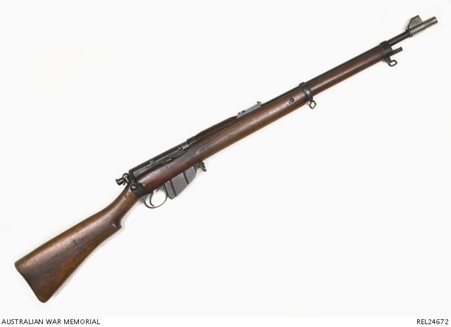
Australian Rifle Club Patter – Image from the Australian War Memorial[4]
It is also noted that by the beginning of the WW1 many old MLEs had already been converted into SMLE’s, mostly between 1903 and 1909.
The Stumpy
The SMLE was known as the “Stumpy” and it was mainly this rifle that served Australian Rifle Clubs until the next change, the conversion to 7.62 NATO.
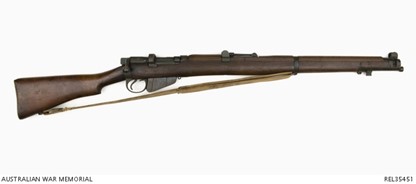
The SMLE No1 Mk3 Image from the Australian War Memorial
Longer serving members of Rifle Clubs (post WW2 era .303 shooters) would recall the use of both “Cutdowns” and “Stumpys” for Rifle Club shooting during the period between the wars and post WW2. Shooting continued using these rifles until the introduction of the 7.62 where rifles became more specifically of a “Target” nature and models such as the Omark were introduced leading up to the large variety of rifles approved for use today.
Ammunition
From 1915, whilst Clubs used a number of different rifles for open range shooting, there appears to be no reference to the use in shooting of any calibre other than .303 British. The following is some background into the development of the .303″ British cartridge used by Rifle Clubs.
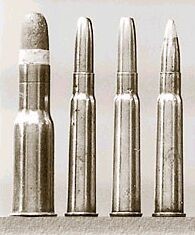
Left to right: the .577/450 Martini-Henry, the MkII .303, the MkV .303 Hollow Point & the MkVII .303
(Photo from The .303 British Website – Charlie Haley)[5]
The .303 was first accepted by the U.K. as the military round in 1888, along with the Lee-Metford Rifle with both cartridge (Swiss) and Rifle (American) being of foreign design. Martini-Henry Rifles were originally in calibre sizes of .450″, and a great number of these were later converted to .303″ along with the ME’s.
The original .303 cartridges as introduced in 1888 used 70 grains of black powder and a round nosed projectile of 215 grains. This was designated Mk1 ammunition and had a muzzle velocity of 1850 fps. Further development came with the introduction of nitro-glycerine based cordite in 1892 with a cupro-nickel jacketed, round nose ball projectile of 215 grains. This was designated Mk1* ammunition. Minor changes to the cartridge required by the change to cordite resulted in the release of MkII ammunition which was also fitted with the round nosed ball projectile turning out a muzzle velocity of around 1970 fps.
Further changes to the .303 cartridge were made following the experiences gained on the North West Frontier of India where it was confirmed that the round nosed ball Mk II round performed poorly when compared against the .303 Dum Dum rounds being produced in India and specially issued at that time (1897) as well as the comparison with the “man-stopping” capability of the old Martini .45″ bullet. The results of investigations were developed to increase the effectiveness in this area and thus came the MkIII round which was a 215 grain, cupro-nickel jacketed hollow point (also made from 1897) and similarly used in the later MkIV (again 1897) and MkV (1899) rounds. These hollow pointed projectiles were soon to be considered to be in contravention of the St Petersburg Declaration and the Hague Convention of 1899 and were subsequently withdrawn in 1903. The remaining stocks of this ammunition were then limited for target practice use.
The term “Dum Dum” is derived from the name of the town in India where these rounds were manufactured (the Dum Dum Arsenal outside of Calcutta) and is now used generally to describe all hollow-point expanding bullets.
A MkVI round was next produced and introduced in 1904 with a 215 grain round nose ball projectile (non expanding in the human body) which had a thinner jacket than the earlier MkII round. The muzzle velocity of the Mk VI was around 2060 fps.
By the time of the First World War, MkVII ammunition was in service having been introduced in 1911. It used a 174 grain spitzer projectile (the term “Spitzer” being derived from “Spitzgeshoss”, the German word for pointed bullet) and tubular cordite charge giving a higher muzzle velocity of 2440 fps. Due to the pressures of war the search for greater ammunition production levels led to the USA, and saw the introduction of a smokeless nitrocellulose powder for the ammunition made there. This was designated MkVIIz and is essentially the way the cartridge remained for the rest of its service life until replaced in the U.K. by the 7.62 NATO cartridge in 1957.
At the beginning of the War, the Australian Army still used the older Mk VI ammunition, which had been manufactured at the Cordite Factory at Maribyrnong, Victoria. The SMLE Mark III rifle was able to use either Mk VI or Mk VII ammunition but the rifle had to be resighted when upgrading to the Mk VII round. Around 15 million Mk VI rounds were sent overseas with the troops in 1914.
As with the “hand-me-down” rifles, it seems that Rifle Club members were carrying out their musketry practice using the earlier Marks of .303 ammunition (probably MkVI) even though it appears most manufacturing in Australia at that time was of the MkVII ammunition.
The MkVII cartridge with its spitzer projectile did not come into use with Australian Target Shooters until 1934. Until then, they had been using the round nosed Marks of ammunition (MkII to MkVI).
Graeme Berman recalled that with the changeover to MkVII ammunition, the effect on improved accuracy was immediate, with 3 shooters scoring 105×105 in the First Stage of the 1934 N.S.W. King’s Prize[6] with this score never having been previously posted. Graeme’s father Herbert William Berman of Chatswood Club was one of the 3 shooters.
Discussion Over MkVI vs MkVII Ammunition and Short Barrels
for Australian Marksmen
Amongst C.H. Cromack’s papers is a letter he penned to the then Minister of Defence, Mr Archdale Parkhill dated 10th October 1935. In this letter Cromack is quite scathing of a reply received from the Minister over several issues including the use of MkVI and MkVII ammunition and the suspension of Open Range Shooting during WWII.
Cromack begins his response:
5. I am sorry I cannot agree that the change-over from Mark VI to MkVII was “acclaimed by riflemen throughout Australia” as a whole. That was not the feeling amongst the thousand or two with whom I came into contact in N.S.W. and I hardly believe those riflemen held different views from those in other states”.
I admit it is easy to be “wise after the event” but would it not have been more expedient if the stocks of MkVI ammunition (which is apparently still serviceable) had been issued to Clubs in 1933 and the changeover to Mark VII deferred another year. I again frankly admit that the Mark VII and Short Rifle has been instrumental in retaining more recruits than any other factor, but what a bad policy the introduction of them at that time will prove, if the impetus the Clubs have thereby received is now to be more than offset by a shortage of ammunition involving a stoppage of shooting.
6. & 7. If these paragraphs are read in conjunction with yours numbered 5, the natural question is – “which way do you want it”. The Mark VII, the serviceability of which the Department was dubious about, was of 1918 manufacture and was issued in 1933. It proved so unreliable and in some instances so dangerous that it was examined, withdrawn and condemned – (fifteen years after manufacture). The 1919 Mark VII has also passed and now in 1935 the 1920 manufacture is in use. I have seen some of that and it is positively not “serviceable and 100% useful in case of emergency”.
8. My view in regard to the usefulness of Mark VI ammunition at this juncture with the Short Rifle represent the opinion of the active riflemen who are being asked to use it. I have read the opinion of the Chairman of the Commonwealth Council regarding this matter. Some Clubs are taking it only because they have no option. Not one rifleman will admit it is worth a jot from the point of view of training as it is not suited to our short barrelled rifles. It only confuses a marksman and spoils his calculations. Many Clubs will not take it even for free.
Your remarks that there should be no appreciable bar to the continuation of our programmes as Mark VI ammunition can be used to supplement Mark VII, conveys what we hope is an erroneous impression, viz. that the Department has no regard whatever for the rifleman’s deep seated ambition to be a first class marksman. Even the novice at rifle shooting knows that competitions commenced with Mark VII ammunition and finished with Mark VI ammunition would result in a farce.
Why is Mark VII ammunition being sold to business firms at less than the cost of manufacture or at any price if there is a shortage of it?
It is suggested that only Mark VI be sold to firms and that Mark VII be given to the riflemen.
Although the depth of the reasoning for Cromack’s frustration is uncertain, an answer may be found in the H.M. War Office Publication – Textbook of Smallarms 1929. Chapter VII, Section 1. contains the following comments amongst others on the MkVI cartridge:
This cartridge was the immediate predecessor of the present service cartridge, and is now virtually obsolete for army purposes, but is still used by certain colonial troops and other forces in the Empire……..
This ammunition was designed for shooting in the long MLE Rifle which is sighted suitably for the ballistics of this cartridge. It is not suited for shooting in the SMLE or short rifle, although the bore and chamber size are the same. as the shorter rifle is sighted for the higher velocity Mark VII cartridge……..
The Changeover to 7.62 mm
The transfer from .303 to 7.62 for Australian Target Shooters came officially in 1969. After a flurry of concerns voiced by riflemen, a “bridging period” began in August/September 1968 where both .303 and 7.62 were made available while shooters came to grips with the conversion of their rifles and for testing. In the U.K., the 1968 Bisley Queen’s had already been competed for with the new cartridge.
From the 1st July 1969, 7.62 was officially launched in Australia and while remaining stocks of .303 were depleted, the NSWRA allowed competition using both types of cartridge. The NSW Queen’s in October 1969 was the first to be officially carried out in Australia with the new 7.62 cartridge.
References:
Much of the information contained in this document is taken from interviews with long serving members of Mosman-Neutral Bay Rifle Club including, Ray Franklin, Graeme Berman, Frank McDermott and Rod Evans. Additional information was gathered from Club records including the papers of C.H Cromack who was a long serving Secretary to the NSWRA.
All other references are detailed in endnotes.

Above: A Commercial BSA[7] Long Lee taken in for Military Service & Marked H.G.S. which is Handsworth Grammar School. At some point this rifle was Sold Out Of Service and ended up in Australia & later converted to the Australian Range Pattern by fitting of a Lithgow Heavy SMLE Barrel. To comply with the Australian Rifle Club rules after the introduction of the SMLE in to Australian Rifle Club Competitions many Long Lees were reduced in length to comply with the new regulations.
[1] https://collections.royalarmouries.org/#/objects
[2] https://collections.royalarmouries.org/#/objects
[3] http://www.euroarms.net/PDF/CA064-0001-SKEN.pdf
[4] https://www.awm.gov.au/collection/REL24672
[5] https://soulofacarp.com/africanhunter/classcart/303_british_rifle_01.htm
[6] Interview with Graeme Berman. Graeme’s father Herbert William Berman was one of the 3 shooters scoring 105/105
[7] https://www.highwoodclassicarms.co.uk/Firerms%20For%20Sale/0253.htm

